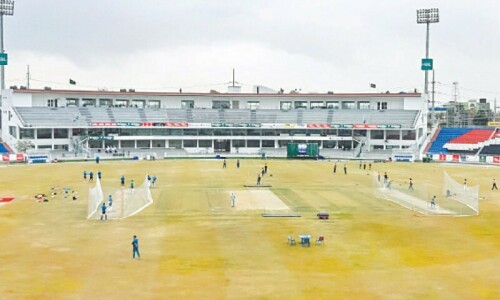Australia speed master Dennis Lillee called a pitch in Pakistan a “graveyard for bowlers” in 1980, but not much has altered more than forty years later.
After laboring for 21 wicketless overs in a tedious tie in Faisalabad Pakistan, Lillee let out his frustration.
The match fizzled out into near farce as all 11 Australian players—including wicketkeeper Rod Marsh—took turns bowling in Pakistan’s 382-2 second innings in response to Australia’s 617 all out.
In the first Test match in Multan Pakistan last week, England rewrote history by amassing 823-7 declared in response to Pakistan’s 556 on a track that former captain Michael Vaughan referred to as “a road.”
In Test history, the total ranked as the fourth-highest single innings.
Joe Root scored a career-high 262 runs to become England’s highest Test run scorer, while Harry Brook amassed 317 at nearly a run a ball.
Their fourth-wicket stand of 454 was an England record, the fourth-highest in history, and the highest by any overseas-playing pair.
England’s bowlers managed to win by 47 runs in an inning despite the pitch’s lack of action, as the home team was reduced to 220 all out in their second innings.
Pakistan became the first team to score 500 or more and lose a Test match by an innings, an undesirable record.
Constant difficulty
The second Test starts in Multan Pakistan on Tuesday. England batting legend Kevin Pietersen claimed on X that bowlers’ lack of support in Multan is “helping destroy Test cricket.”
“It’s a recurring issue,” ex-captain Wasim Akram told AFP.
“The same old story has been told for years. In the 1990s, green, active grounds were extremely uncommon, and we frequently had to bowl lengthy spells to get wickets.
Former captain and wicketkeeper Rashid Latif, who has studied pitch preparation, stated that the pitches didn’t need to be so heavily stacked in favor of the batsmen.
“Our mindset is negative, even though we can prepare good pitches,” Latif said to AFP.
“The Multan pitch had nice grass, but it was shaved off—I’m not sure who wanted it removed.”
“Our batters want a flat pitch to score runs,” stated Tauseef Ahmed, a former spinner and selector who was part of the team that participated in the historic 1980 Faisalabad Test.
“We have such pitches even in domestic matches so that players get big scores and recognition.”
Pitches have become even more submissive during the past two years. The highest average cost in the world, 42.13 runs, is currently required to claim a wicket in a Test match.
The curator, who wished to remain anonymous, stated, “There are several factors, from weather to interference from the team management who want it to suit them.”
This adds complexity to the procedure. A quality pitch requires sunlight to bake, but certain weather conditions prevent it,” he stated.
“We overuse our pitches, which causes them to become flat. A test pitch should be cared for for six months or a year.”
Dark phases of Pakistan
According to Latif, much effort is required to raise the caliber of pitches.
According to Latif, “a good geologist should head a research department to figure out how to prepare a good pitch.”
In order to aid bowlers, he also wanted Pakistan to replace the Australian Kookaburra balls with ones that have a more noticeable seam.
“Our kind of clay is hand-stitched, so we need Grays, Duke, or SG balls,” Latif stated.
In a sultry draw in Rawalpindi two years prior, Pakistan and Australia combined for 1,187 runs while only losing 14 wickets.
“We live in the dark ages of pitches in Pakistan,” declared Ramiz Raja, the then-head of Pakistan’s cricket team, in an attack on the field. This advertisement for Test cricket is poor.
To Keep Updated Visit & Follow our Facebook Page Or Our Website




